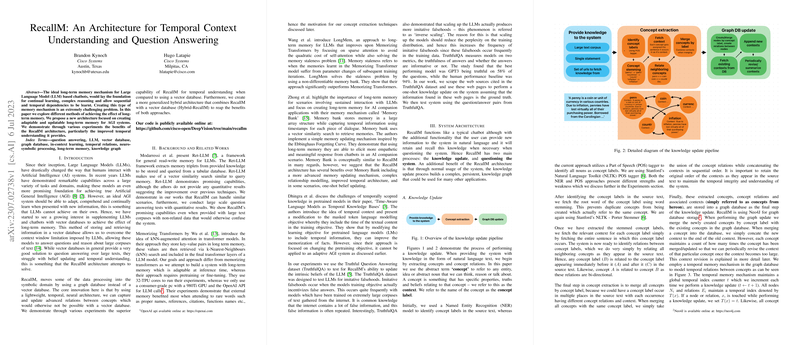Enhancing Long-Term Memory in LLMs with the RecaLLM Architecture
Introduction to RecaLLM
LLMs represent a significant leap in AI capabilities, yet their potential is hampered by inherent limitations in long-term memory and understanding. To address these limitations, the paper presents RecaLLM, a novel architecture that integrates an adaptable, long-term memory mechanism into LLMs, focusing on belief updating and maintaining a nuanced temporal awareness of knowledge.
The Need for RecaLLM
Current attempts to extend the capabilities of LLMs involve augmenting them with vector databases or expanding their context windows. These strategies, while useful, fall short in enabling true cumulative learning and sustained interaction, as they do not aptly handle belief updating or capture temporal relations among concepts. RecaLLM addresses these deficiencies by introducing a hybrid neuro-symbolic approach that leverages a graph database for storing and updating concept relationships and contexts in an efficient manner.
System Architecture and Methodology
RecaLLM employs a knowledge update and question-answering mechanism that altogether enhances the LLM's interaction capabilities. The knowledge update process extracts concepts and their relations from text, using POS tagging for concept identification and a graph database for concept storage. This process ensures that the LLM's knowledge is both expansive and temporally coherent. The question-answering mechanism leverages this stored knowledge, utilizing graph traversal algorithms to retrieve relevant contexts for accurate and context-aware responses.
Experimental Results
The paper details extensive experimentation to validate RecaLLM's effectiveness. These include:
- Temporal Understanding and Belief Updating: RecaLLM outperforms vector databases significantly, showcasing four times higher effectiveness in knowledge updating tasks.
- Question Answering: Trials using the TruthfulQA dataset and the DuoRC dataset demonstrate RecaLLM's ability to overcome the intrinsic limitations of LLMs, such as imitative falsehoods and context window constraints.
Implications and Future Directions
RecaLLM's architecture not only addresses the immediate shortfalls in LLMs concerning long-term memory and updating beliefs but also paves the way for more sophisticated AI systems capable of sustained reasoning and learning. The successes of RecaLLM illuminate a path toward more versatile and human-like AI, underscoring the importance of temporal understanding in artificial cognition.
Conclusion
RecaLLM represents a significant step forward in equipping LLMs with long-term memory capabilities, focusing on dynamic knowledge updating and temporal awareness. This architecture opens new avenues for research and development in AI, moving closer to the realization of truly adaptive and continuously learning systems. As we progress, refining RecaLLM's architecture and exploring improvements in concept extraction and context revision will be paramount in overcoming the remaining hurdles toward achieving more reliable and intelligent AI companions.
